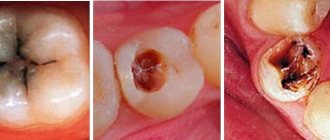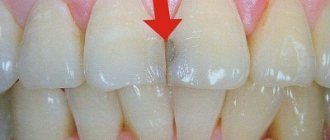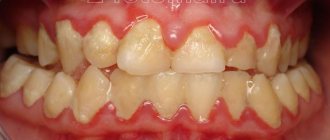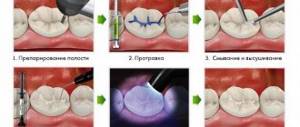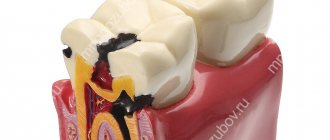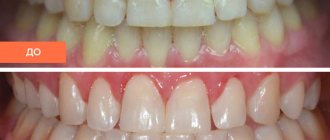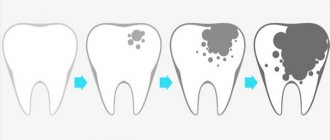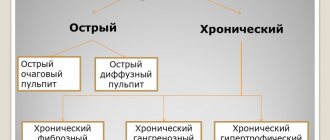A drill always evokes a feeling of fear in everyone. Of course, who likes to hear buzzing and drilling in the tooth, which is sometimes accompanied by even unpleasant sensations. But technology has long stepped forward, so now there is a unique method of restoration that does not use standard methods of cleaning the dental cavity. One of these is the Icon caries treatment technology. Due to the fact that this method of treatment does not use a drill, it has become quite popular among many patients. But still, before using this method, you need to carefully study its features.
Liquid filling Icon: what is it?
Icon is an abbreviation for the words Infiltration Concept, which means “infiltration concept”.
Infiltration is a microinvasive, that is, gentle dental treatment. The principle is that the liquid light-composite material penetrates the porous enamel and reliably “seals” the exposed surface of the tooth. The drug Ikon was developed by the German company DMG and has been used around the world since 2000.
How did Icon technology come about?
Icon, short for Infiltration Concept, which means “infiltration concept”. This technology was developed by the German company DMG, then it began to be widely used in European countries, and today it is already gaining popularity in Russia.
This treatment is minimally invasive and very popular in modern medicine, as it involves minimal interference in the natural functioning of the human body.
This technique works by introducing a polymer composition into the area affected by caries. The main objective of this treatment technology is to seal the affected cavity and stop the proliferation of pathogenic bacteria. At the same time, Icon helps restore the previous density of dental tissue and makes it much more resistant to acids in the future. Infiltration is an innovative method in dentistry.
This procedure is indicated for the early stages of caries development, when it appears as a white or dark spot on the enamel. That is, when there is no carious cavity on the surface yet.
It is especially convenient to use this technique when caries affects places that are difficult to reach. It is difficult to clean the spaces between teeth with a drill, but with the help of Icon, you can easily carry out treatment, since the device has very thin applicators.
Icon is often used to treat dark spots after braces are removed. Thus, caries is stopped at its early stage, protecting the beauty of the patient’s smile. In this case, tooth enamel does not crack, its color and transparency are preserved.
Peculiarities
Infiltration using the Icon method has the following features:
- Its use gives positive results in the early and middle stages of the disease, until it progresses to a deep stage. Deep caries cannot be cured by this method; for such a disease, it is advisable to perform a filling using the classical method.
- Icon strengthens tooth tissues and promotes their future resistance to the effects of acids. With this method of treatment, the layer of the tooth affected by caries is also removed by burning, but it is much less than when using a drill. Also, the new technology resists cracks in the enamel, which remains hard after the procedure.
- Icon cannot always stop tooth decay. In some cases it may return. In this case, restoration of the dental organ and its treatment using the classical method are used. But such cases are very rare. At the same time, it is important to understand that the patient will not lose anything special, since, without using the Icon, he would still have to use a drill.
Compound
- Etch: hydrochloric acid, pyrogenic silicic acid, surfactants
- Dry: 99% ethanol
- Infiltrant: methacrylate resin matrix, initiators, additives
Release forms
Icon Kariesinfiltrant - approximal Starter kit of 2 treatment kits Pack of 7 treatment kits
Icon Kariesinfiltrant - vestibular Starter kit of 2 treatment kits Pack of 7 treatment kits
Each treatment kit contains: Kariesinfiltrant - approximal • 1 Etch syringe with 0.3 ml liquid • 1 Dry syringe with 0.45 ml liquid • 1 Infiltrant syringe with 0.45 ml liquid • Accessories
Kariesinfiltrant - vestibular • 1 Etch syringe with 0.45 ml liquid • 1 Dry syringe with 0.45 ml liquid • 1 Infiltrant syringe with 0.45 ml liquid • Accessories
Advantages and disadvantages
Like any other type of treatment, Icon has both pros and cons. Let's consider both.
Advantages:
- Minor tooth decay can be treated without preparing it.
- Short duration of treatment, approximately 20-25 minutes.
- No anesthesia or drill is used. The procedure is absolutely painless.
- Healthy tissues of the dental organ are not loaded, as happens with classical treatment.
- The area treated with this method is completely invisible against the background of other organs of the oral cavity.
Flaws:
- such treatment gives results only in cases of superficial tissue damage; it does not treat deep caries; it requires the tooth to be prepared and filled;
- the cost is significantly higher compared to classical treatment. This procedure will cost approximately 3.5-4 thousand rubles. And in economy class dentistry it is perhaps a little cheaper;
- Only a highly qualified and advanced specialist in the field of new technologies can carry out such treatment efficiently;
- To date, there is no consensus among experts regarding such treatment. There are both its supporters and opponents;
- With this technique, a thin layer of the tooth still evaporates, although it is much smaller than when using a drill. At the same time, it is not always possible to stop caries, and the patient must subsequently resort to drilling.
Indications for the procedure
It’s not for nothing that doctors call caries treatment using the Icon method a “dental miracle.” The technology makes it possible to remove carious defects using various medicinal compounds and does not require the use of a large number of specialized instruments or the introduction of anesthetics. Its use is relevant in the following situations:
- Initial caries. Dentin should be affected no more than 30%. But the best results can be achieved when only external damage to the enamel is detected.
- Chalk spots that appear as a result of prolonged wearing of braces.
- Unadvanced caries, localized in poorly accessible areas of the mouth.
This is interesting: Periodontal pocket: causes of pathology, treatment and prevention
Also, “Icon” is suitable for people who suffer from dental phobia, that is, they are panicky afraid of the dentist and cannot bring themselves to cross the threshold of his office.
Contraindications
There are two main contraindications to the use of the Icon technique:
- Late caries affecting deep layers of enamel; this type of disease requires drilling out the affected tissue and filling the cavity.
- Childhood. For such treatment, special concentrated acids are used that can harm the child’s body. At the same time, a sufficient duration of the procedure requires patience and perseverance, which children usually lack.
Characteristics
The Icon infiltration treatment method has a number of features:
- This treatment method is effective when dental caries is not yet in an advanced stage. If it is used already at advanced stages, then its use will not give any results and will be ineffective;
- Using this method, increased strengthening of the structure of dental tissue is ensured, which can subsequently protect against acid attack.
Important! It is worth considering that during this technology a thin layer of dental tissue is burned out, but this is still much less than when using a drill.After the Icon infiltration method, the enamel does not crack and retains its original structure;
- This treatment method cannot always stop the spread of the carious lesion, sometimes it continues to spread. In these cases, the tooth structure is restored and treatment is performed according to the classical method.
Impregnation of the enamel with colorless monobond is Icon infiltration. This method allows you to get rid of caries at the spot stage. With its help, natural remineralization of carious lesions occurs.
When is dental treatment performed without a drill?
Treatment with the Icon method is used only at the initial stage of caries (surface stain stage). There are several categories of carious lesions based on the depth of the lesion. According to the degree of penetration into the enamel, forms E1 and E2 are distinguished, and according to the depth of penetration into dentin - D1, D2 and D3.
With the help of infiltration, only defects of types E1, E2 and D1 can be eliminated. That is, with a deep carious “hollow” that has affected most of the dentin, it is already necessary to drill out the affected areas and place a filling.
The drug can be used for damage to any area of the enamel, including the cervical and interdental area, as well as on fissures (the surface of chewing teeth). Sure signs that you should use Icon are the formation of a chalky spot on the crown and increased sensitivity to cold and hot foods.
There is no point in using the solution on healthy enamel, for example, for the purpose of remineralization. In this case, it is better to carry out fluoridation. There are no other contraindications to the use of Icon.
What is microinvasive caries treatment and when is it used?
The stain stage, when the tooth enamel has already begun to lose minerals, but there is no carious cavity in it yet, is considered the most favorable in terms of the effectiveness of treatment. At this stage, the carious process is reversible, and with timely treatment, it can be stopped and the enamel restored to its previous strength. At the same time, to treat a carious stain, you do not need to prepare the tooth; caries at this stage can be easily treated using microinvasive methods. One of them is ICON technology - infiltration treatment. This technology was invented in Germany and has been certified and successfully tested in many European countries. Today it is widely used by Russian dentists to treat the early stages of caries in children and adults.
The procedure for treating caries using the Icon method
The Icon gentle treatment procedure takes from 15 to 30 minutes, depending on the number of carious lesions in the oral cavity.
In this case, there is no buzzing or vibration of the drill, and no painful sensations arise. The set includes several applicators with different drugs that need to be applied alternately.
Stages of treatment using the Icon method
The Ikon procedure has several stages. Let's look at it step by step:
- First, the tooth must be thoroughly cleaned of stone and plaque, and also polished.
- The tooth surface for infiltration must be completely dry. Therefore, the affected dental organ is isolated from the oral cavity using a special latex plate (cofferdam).
- Next, the teeth need to be moved away from each other. For this purpose, special wedges are used. Wedging is not particularly pleasant, but quite tolerable.
- The tooth is then prepared for infiltration. A special gel is applied to it, which is left for a couple of minutes so that the tooth is etched and the porous part of the initial caries becomes accessible to the specialist.
- Next, the gel is removed, and the tooth surface is dried again.
- Then a tip is put on the Icon-Dry, with which one special polymer is first applied to the tooth (for half a minute), then, after drying, another infiltrate is applied (for 3 minutes).
- At the last stage, a supercomposite material is applied, which is then polymerized for 40 seconds using a special lamp.
The dentist may invite the patient for a follow-up appointment after the procedure, a few days later. Thus, he can monitor the condition of the treated organ.
The formulations used in the Icon treatment are highly penetrating. For this reason, tooth tissues become saturated very quickly. At the same time, even microcapillaries are sealed against the penetration of harmful bacteria. So, caries stops.
This technology is also good because there are no changes in the anatomical structure of the tooth. The drill is not used, which means healthy tissue is not affected.
With this treatment, the patient receives only positive emotions.
According to experts, this type of treatment is very simple. Three different drugs are sequentially applied to the tooth. And the results in most cases are excellent.
Instructions for treating proximal surfaces
- The syringes included in each kit contain material to treat two proximal lesions.
- In the case of treating multiple lesions of the proximal surfaces during one session, treatment of the lesions is carried out sequentially.
Instructions for treating vestibular surfaces
- The syringes included in each kit contain enough material to treat two to three lesions of the vestibular surfaces.
- Treatment of several lesions on the vestibular surfaces can be carried out in parallel.
- Liquid Dam can also be used for use on vestibular surfaces.
- Treatment of patients after orthodontic treatment, after removal of braces: if the treatment of white spots is carried out later than 1-2 months after removal of braces, etching should be done twice. If the white spot is still visible after applying Dry, a third etching is recommended.
- A total of up to three etches with the Icon-Etch can be carried out for 2 minutes each.
- When treating local caries at the white spot stage, an area with a radius of 2 mm around the lesion is etched. If there are large white spots, such as after braces have been removed, the entire smooth surface should be etched and treated at the physician's discretion.
Care
As a rule, after treatment you do not need to follow any special instructions. The basic rule is to stop smoking, drinking coffee and other coloring drinks or foods for 2 hours.
This is interesting: Classification of periodontitis - types of diseases according to ICD-10
The dentist may also recommend that the patient come back in a few days to ensure the quality of the procedure.
Of course, it is necessary to carry out a number of mandatory hygiene measures familiar from childhood:
- oral hygiene procedures twice a day, paying special attention to brushing your teeth in the evening;
- use floss (dental floss) to remove food debris;
- rinse your mouth after eating.
Modern technologies for effective caries prevention
E. A. Tyo
Doctor of Medicine, Professor, Head of the Department of Therapeutic Dentistry, Kemerovo State Medical Academy
In the structure of dental morbidity, dental caries occupies one of the leading places. The prevalence and intensity of caries among the Russian population reaches 99% [6]. The high incidence of dental caries is largely due to the peculiarities of their structure, function, the presence of microflora, and constant contact with oral fluid and food products [1, 11].
Experience accumulated in recent decades shows that the increase in pathology of hard dental tissues cannot be stopped solely by therapeutic measures [10, 27]. Therefore, all efforts of specialists should be aimed at preventing dental caries using innovative technologies and materials available on the global dental market and developed based on the results of evidence-based scientific research [2, 15, 16].
Currently, caries is considered an infectious disease, the likelihood of development and severity of which depends on many factors. In the modern understanding, the occurrence of caries is the result of a combined effect on the surface of teeth of bacteria and their metabolic products over a long period of time. The basis of the disease is the utilization of carbohydrates by the microflora of the oral cavity with the formation of acids. Practical implementation of the cariogenic influence of the main (but not the only) culprit of caries - Str. mutans - occurs through colonization in the oral cavity, carried out in the form of formation of dental plaque (in modern terminology, microbial biofilm). Dental plaque begins to form almost immediately after brushing the teeth, and its composition dynamically changes from the dominance of aerobic and facultative anaerobic forms, predominantly gram-positive cocci, to obligate anaerobic gram-negative rods and convoluted forms [4, 12].
It has been established that after ingestion of carbohydrate food in the oral fluid there is a sharp increase in the enzymatic activity of planktonic bacteria - a “metabolic” explosion, the basis of which is the activation of glycolysis. This leads to a sharp shift in pH to the acidic side due to the release of acidic catabolites - acetic, lactic, formic, pyruvic and other acids. In addition, the pH under the dental plaque decreases, and the process of demineralization of the tooth enamel begins. This occurs as a result of the ability of biofilm bacteria to accumulate excess carbohydrates in the form of reserve polysaccharides - dextrans and levans - with their subsequent metabolism, mainly through glycolysis, with the formation of organic acids. The structural elements of the enamel begin to lose ions, and a focus of demineralization occurs. Thus, the microbial biofilm initiates the development of the carious process [13, 21, 24].
Subsequently, the vital activity of the dental plaque microflora is successfully supported by the polysaccharides it stores for future use, which can be utilized, including between meals, ensuring the existence of microorganisms and the production of acids on the enamel surface during the entire period that the biofilm is on the tooth surface [14]. Taking this into account, the main etiological and etiotropically justified methods of combating dental caries should be the elimination of oral microflora pathogenic in relation to caries, reducing its quantity and cariogenicity, mainly by eliminating dental plaque and food debris. However, none of the methods existing today can achieve a significant reduction in the concentration of Str. mutans for a period of more than six months. Therefore, in order to select the most effective method of caries prevention, the prevention of plaque formation along with the removal of existing plaque is crucial [7, 30].
The main role in caries prevention continues to be the careful removal of dental plaque through regular tooth brushing. The goal of other measures for the prevention of caries, which are pathogenetically determined, is to give the hard tissues of the tooth greater acid resistance and stimulate their remineralization. Fluorides, including those included in oral hygiene products, successfully cope with this role. Fluorides can not only reduce the solubility of enamel in an acidic environment, stimulate remineralization, that is, influence the resistance of teeth to caries, but also inhibit the metabolism of plaque bacteria.
Fluoride ions can stop the enzymes that bacteria use to process sugars for energy. During this process, the formation of acids occurs, therefore, fluorides help reduce the production of acids. However, inhibition of bacterial activity occurs only in the presence of a high concentration of fluoride ions, which is impossible to achieve in the biofilm after using professional products and hygiene products containing fluoride. However, fluoride is the only clinically proven anti-caries agent used for routine use in oral hygiene products on a global basis.
Enamel behaves like a permeable membrane, and small ions penetrate into the depths more easily than large molecules that are adsorbed on the surface. In apatite, up to a third of ions can be exchanged. Penetration of substances into enamel and ion exchange occur in several stages. First, from the surface of the enamel, ions penetrate into the hydration layer of the crystal, from there to the surface of the crystal, and only subsequently from the surface to various sections of the crystal lattice. If the first stages last for several minutes and hours, then the last stage, the stage of intracrystalline ion exchange, lasts up to several months [1].
The possibility of remineralization of the focus of carious lesions in the initial stage of development of the pathological process (enamel caries in the spot stage) is due to the protective layer of calcium fluoride, which is a depot of fluoride ions in the oral cavity, from which fluoride is constantly released in small quantities. During acid attacks, the amount of fluoride released from the depot increases. The constant presence of fluoride in low concentrations in saliva enhances and accelerates the natural protective mechanism of remineralization [3, 5]. Thus, thanks to the remineralization process, the lack of minerals in the superficial localization of carious lesions can be replenished, caries in the spot stage can be stopped, and the tissue structure can be restored.
Fluorides increase the resistance of dental tissues to the demineralizing effects of acids and promote the processes of remineralization of hard tissues by retaining calcium and phosphates in close proximity to the tooth surface [5]. Compared to systemic fluoridation methods, recently more and more importance has been given to the application of fluoride-containing products directly to the tooth surface, including when using personal oral hygiene products. To date, literary sources are unanimous in the opinion that CaF2 temporarily becomes a reservoir of fluoride ions, maintaining a low concentration of fluoride in the oral cavity for a long time, including between hygiene procedures.
The main fluoride-containing compounds used in modern professional and oral hygiene products are sodium fluoride (NaF), sodium fluorophosphate (NaPO3F), sodium monofluorophosphate (NaMFP), aminofluoride (AmF).
The most important factor influencing the remineralization of enamel is also saliva. The physicochemical parameters of saliva are stable, which makes it possible to ensure homeostasis of the “saliva - dental plaque - tooth enamel” system. Mechanical brushing of teeth using toothpastes can be attributed to an external intervention in the oral ecosystem, which causes certain temporary changes in saliva. First, toothpaste works as an irritant, increasing the rate of saliva secretion; secondly, it contains chemicals, in particular fluoride ions, which temporarily become components of the oral fluid, inevitably affecting its composition and properties [3, 7]. Such parameters of oral fluid as a high secretion rate, a shift in pH to the alkaline side, a high concentration of total and ionized calcium and a relatively low content of organic phosphate characterize the saliva of caries-resistant individuals [1].
For the prevention of caries, conservative and minimally invasive technologies are currently in demand that promote the remineralization of early carious lesions and the elimination of the carious process at a very early stage [20, 25]. In particular, such technologies include a probiotic approach to caries prevention, implemented through the use of arginine, which complements the traditional effect of fluorides [26].
Arginine is a naturally occurring amino acid that is an essential building block for cell growth and is normally present in saliva. Arginine is a natural component found in many foods. The US Food and Drug Administration (FDA) classifies arginine as a GRAS (Generally Recognized as Safe) ingredient for use as a food additive.
The principle underlying the new caries prevention technology allows modulation of plaque pH by using the arginine deaminase enzyme pathway in non-pathogenic, arginolytic microorganisms. Arginolytic bacteria are able to break down arginine into ammonia, which neutralizes plaque acids directly in its matrix, stabilizing the microbial biofilm [8, 23].
Clinical studies have shown that exogenous sources of arginine can affect the activity of the arginine deaminase system. In a group of people brushing their teeth twice a day every day for four weeks with toothpaste containing only arginine, due to increased activity of the arginine deaminase system, the risk of caries decreases, which is comparable in effectiveness to fluoride-containing toothpaste [18].
The action of fluorides is concentrated on dental tissues as a means of controlling damage after the onset of the carious process, and arginine affects pathogenic plaque and prevents the onset of the carious process [22].
Since the mechanisms of action of arginine and fluoride complement each other well, a new generation of oral hygiene products has been created that combines arginine, an insoluble calcium compound and fluoride - a toothpaste containing 1.5% arginine, a calcium compound and 1450 ppm fluoride.
The action of toothpaste based on the “sugar acid neutralizer” technology is aimed at neutralizing acids directly in the plaque biofilm as the main cause of caries, and is also supplemented with the main benefits of fluorides. Using modern and traditional methods of caries detection, it has been clinically proven that toothpaste based on this technology can provide more effective caries prevention, reducing the formation of new cavities by 20% compared to toothpaste containing only fluoride.
The effectiveness of toothpastes containing 1.5% arginine, a calcium compound and 1450 ppm fluoride has been confirmed by eight years of clinical studies involving 14,000 people [9, 17, 19, 28, 29, 31, 32].
One of these studies in Chengzhu (China) involved 463 schoolchildren aged 9–13 years with initial carious lesions of the teeth. To detect and evaluate carious lesions, including long before the formation of a cavity, one of the most modern caries diagnostic methods was used - QLF (quantitative light-induced fluorescence) [13, 29]. Over the course of six months, changes in initial caries were recorded in children randomly divided into three groups that had no statistically significant differences in baseline data and used arginine-containing toothpaste and two control products. The positive control is a silica-based paste containing 1450 ppm of fluoride in the form of sodium fluoride, the negative control is a fluoride-free product. After six months of twice-daily brushing, improvements from baseline in ΔQ (lesion volume) were 50.6%, 34.0%, and 13.1%, respectively, for the novel arginine toothpaste, positive control, and negative control groups. . The difference between the study group and the positive control group was statistically significant (p = 0.003), as well as the difference between the negative and positive control groups and the study group (p < 0.001), which suggests that the identified differences in the data obtained are not random and , therefore, are reliable. [31]. This suggests that the new toothpaste, containing 1.5% arginine, a calcium compound and 1450 ppm fluoride, was more effective in inhibiting the development of caries and promoting the reversal of early caries lesions compared to a regular toothpaste containing only 1450 ppm fluoride.
Another larger, longer-term, double-blind, randomized, controlled, parallel clinical trial involving 5,559 participants showed similar results. Two years of observation showed that two toothpastes containing 1.5% arginine and 1450 ppm calcium fluoride, one with dicalcium phosphate and the other with calcium carbonate, were significantly more effective in preventing cavities than toothpaste containing only 1450 ppm fluoride. Three trained and calibrated examiners examined the baseline status of children aged 7–12 years, repeating the study one and two years later. In three groups of study participants randomly assigned to different toothpastes, the numbers of caries-affected, filled, and removed teeth due to complications of caries (CPUz) and surfaces (CPUp) at baseline were almost the same, with no statistically significant differences between groups, as well as after one year of use. However, after two years, children using toothpastes containing 1.5% arginine, a calcium compound and 1450 ppm fluoride had statistically significant (p < 0.02) lower CBF values (21.0 and 17.7% reduction, respectively). ) and KPUp values (16.5 and 16.5%) compared to the control dentifrice without arginine. The differences between the two groups using the new teeth cleaning products were not statistically significant.
Nowadays, the population is quite well motivated in matters of oral hygiene, does not lack a choice of hygiene products and usually chooses toothpastes containing fluoride. However, the problem of caries is still relevant. The advent of arginine-containing toothpaste makes it possible to maintain the acid-base balance of the oral cavity at normal levels, making the intraoral environment safe for the mineral components of enamel and unfavorable for cariogenic bacteria, and provides a new chance for more effective caries prevention, increasing the potential for the action of fluorides.
Recommendations for use
Treatment of proximal surfaces with Icon Kariesinfiltrant – approximal
- Before treatment, clean the tooth being treated and adjacent teeth. After cleaning, remove all residues with a water jet. Apply rubber dam.
- Insert one of the supplied spacer wedges into the space between the teeth. In order for the wedge to better enter the proximal part, its handle can be rotated at an angle. — For the necessary separation of the teeth, the wedges must be inserted to a sufficient depth of the interdental space. – To ensure successful treatment, the teeth must be separated by approx. at 50 µm. This can be done in stages: insert the wedge until you feel resistance. Wait 3-5 seconds, then gradually insert the wedge deeper until the widest part of the wedge sufficiently separates the teeth. — Leave the separating wedge in the proximal space throughout the procedure.
- Screw the proximal tip onto the Etch syringe and insert the tip into the interdental space. In this case, the green side of the proximal nozzle should be directed towards the surface being treated. — The material comes out only from the green side of the film. Carefully! Improper use of Etch may cause pain to the patient. — Icon-Etch should only be used on enamel. Do not use on exposed dentin or filled areas.
- Apply Etch with a small excess to the affected area. 1.5 - 2 turns of the piston approximately correspond to the required amount of material. Leave Etch on for 2 minutes. If necessary, remove large excess material. — The syringe is controlled with one hand.
- Remove the application film from the interdental space. Suction off the Etch and rinse with water for at least 30 seconds. Then dry with dry air from an oil-free compressor.
- Screw the tip (needle) onto the Dry syringe, apply the material with a slight excess to the affected area and leave to act for 30 seconds. Then dry with dry air from an oil-free compressor. — Do not apply Icon-Infiltrant under direct light from a dental light as this may cause premature polymerization of the material.
- Screw the new proximal tip onto the Icon-Infiltrant syringe and insert the tip into the interdental space. In this case, the green side of the proximal nozzle should be directed towards the surface being treated. — The material exits only from the green side of the proximal nozzle.
- Apply Icon-Infiltrant with a slight excess to the affected area. 1.5 - 2 turns of the piston approximately correspond to the required amount of material.
- Leave Icon-Infiltrant to act for 3 minutes, adding material if necessary.
- Remove the attachment from the interdental space. Remove excess material using dental floss.
- Illuminate Icon-Infiltrant from all directions for at least 40 seconds.
- Screw the new proximal tip onto the Icon-Infiltrant syringe and apply the material a second time (steps 7-8) and leave for 1 minute. Remove the attachment from the interdental space. Remove excess material using dental floss. Then illuminate the material from all sides for at least 40 seconds.
- If the next affected area is treated during the same treatment session, repeat steps 1 to 12.
- Remove the separating wedge and rubber dam. Surface polishing is carried out using strips.
Treatment of vestibular surfaces with Icon Kariesinfiltrant – vestibular
- Before treatment, clean the tooth being treated and adjacent teeth. After cleaning, remove all residues with a water jet. Apply rubber dam.
- Screw the smooth surface attachment onto the Etch syringe. Carefully! Improper use of Etch may cause pain to the patient. — Icon-Etch should only be used on enamel. Do not use on exposed dentin or filled areas.
- By turning the plunger, carefully apply Icon-Etch with a slight excess to the affected area and leave to work for 2 minutes. If necessary, remove large excess material with a cotton swab. — The syringe is controlled with one hand. Note: If treatment of white spots is carried out later than 1-2 months after removal of braces, etching should be carried out twice. If the white spot is still visible after applying Icon-Dry, a third etching is recommended.
- Remove by aspirating Etch and rinse with water for at least 30 seconds. Then dry with air from an oil-free compressor.
- Screw the tip (needle) onto the Icon-Dry syringe, apply the material with a slight excess to the affected area and leave to act for 30 seconds. Then dry with dry air from an oil-free compressor. Note: When Icon-Dry is wetted, the whitish-matt color of the enamel will become less pronounced. If this does not happen, the etching process should be repeated a second and third time (two minutes each) and the surface of the teeth should be rinsed and dried again (step 3-5).
- Screw the new vestibular attachment onto the Icon-Infiltrant syringe. — Do not apply Icon-Infiltrant under direct light from a dental light as this may cause premature polymerization of the material.
- Rotate the plunger and apply Icon-Infiltrant in a slight excess to the etched surface.
- Leave Icon-Infiltrant to act for 3 minutes. Remove excess material with a cotton swab and, if necessary, dental floss.
- Illuminate Icon-Infiltrant for at least 40 seconds.
- Screw a new vestibular attachment onto the Icon-Infiltrant syringe, apply the material a second time (steps 7-8) and leave for 1 minute. Remove excess material with a cotton swab and, if necessary, dental floss. Then shine for at least 40 seconds.
- Remove rubber dam. Surface polishing is carried out using, for example, strips.
This is interesting: Review of the best ointments that will help with stomatitis in the mouth of a child and an adult
Treatment of dental caries with the Icon system in dental clinics in Nizhnekamsk
- Dental office 32 plus
- Vakhitova Avenue, 43
- +7 (8555) 36-… show all
- Mon-Fri 8:00–20:00; Sat 9:00–15:00
3.9 ratings: 8
- Koyash
4.4 ratings: 12
- Tatdent
3.8 ratings: 9
- Radent
3.7 ratings: 10
- Dental office
4.4 ratings: 9
- Comfort
4.4 ratings: 8
- Ra-dent
4.4 ratings: 8
Forecast
Most patients note a positive result of treatment.
However, this does not mean that the technology is a miracle of medicine and will save in all cases. The deeper the carious lesion, the worse the result. This is due to the fact that during the etching process, not all dentin layers are reached.
Thus, if you already have an average degree of caries damage, you should not expect a Hollywood smile from the procedure, so as not to be disappointed with the result.
Should I use Icon?
Thanks to new developments in dentistry, treatments are improving more and more rapidly, and the drill will sooner or later be replaced by an alternative method of treating caries.
The Icon method has only been used in Russia for six years. For this reason, Russian specialists do not yet have much experience in its use. At the same time, the cost of the procedure exceeds the price of the classical method of caries treatment. And only certain categories of people who take the most careful care of their teeth can use it.
In addition, numerous surveys of dentists have shown that most patients come to treat medium and deep caries, and the initial stage is rarely treated.
But still, a patient who has been diagnosed with early caries should see a dentist who knows the Icon technique. And if your doctor recommends using it, you shouldn’t refuse. After all, with this method, healthy tooth tissue is preserved, and the effect on it is more gentle, compared to classical treatment. At the same time, the patient will always have time to drill the tooth if necessary.
Icon's popularity is gradually growing. It is gradually being introduced not only into expensive, but also into clinics for the middle class. Therefore, it is worth trying out the effects of new developments for yourself.
Side effects
- In some cases, contact allergies to products of identical composition have been described.
- If Icon-Etch comes into direct contact with the oral mucosa, the contact area may turn white. This symptom will disappear in a few days.
Advantages and disadvantages of the procedure
Treatment of caries without an icon drill, according to patients who have experienced this method of eliminating caries, has many advantages:
- Firstly, this is the complete preservation of the healthy part of the tooth.
- Secondly, preventing further tooth destruction and the spread of caries to neighboring ones.
- Thirdly, the complete naturalness of the treated dental unit.
- Absolutely painless.
- Does not require the use of painkillers.
- Treatment in one visit to the dentist.
- Ease of treatment in hard-to-reach places.
Despite the obvious advantages of this method, it is not without some disadvantages:
- Price of treatment icon. Compared to other methods, the cost of the procedure is significantly higher. On average, in Moscow dental clinics you will have to pay about 4,000 rubles for the treatment of one tooth.
- The effectiveness of the method is possible only at the initial stages of caries development.
- If the depth of the lesion is incorrectly determined, a negative result is possible, which will require further treatment using traditional methods.
Alternatives
Until recently, there were only two ways to treat early caries - prevention through fluoride treatment and an invasive technique involving preparation and restoration of the affected tissue.
Undoubtedly, one of the analogues is classical preparation with filling with a composite material (installation of a filling), which involves the use of a drill.
There are also more modern methods, which, unfortunately, are not relevant in all cases.
For example, remineralization is carried out at the initial stages of disease development. This method involves restoring the mineral composition of the protective layer and removing deposits . This technique helps to compact the enamel and enhances its resistance to carious lesions .
There is also an ART method, where instead of a drill, excavators are used, which literally “scrape off” tissue affected by caries . Afterwards, the cavity is filled with glass ionomer cement, which releases fluoride into the tissue, thereby preventing the development of caries.
Interaction with other substances
- This material cannot be used with substances that inhibit polymerization.
- Particularly with materials containing eugenol, such as temporary cements.
When is it prohibited to use the technique?
Using ICON technology, caries is treated at an early stage, when there is no carious cavity in the dentin yet.
The technology cannot be used in the following cases:
- deep damage to the enamel;
- the presence of a carious cavity in dentin;
- exposed tooth roots;
- cervical caries.
Since the method is effective for the treatment of caries in the stain stage, it is important to pay great attention to the prevention of dental caries. In particular, visit the dentist twice a year, even if there are no complaints of toothache, bad breath or other symptoms. During a routine examination, the doctor may find a stain on the surface of the enamel that can easily be treated with the Icon method.
Dentists' opinions
Dentists have an ambivalent attitude towards infiltration treatment.
Some believe that this procedure is effective and necessary in modern dentistry. Other experts consider it an ineffective and unnecessary technique, remaining adherents of classical methods of treatment.
Pediatric dentists have a special relationship with Icon technology, arguing for its effectiveness, ease of use, and the absence of any pain in children.
In addition, the gentle method will allow children in the future not to feel afraid of visiting the dentist’s office.
In the video, a specialist answers frequently asked questions regarding Icon dental treatment technology.
Price
Icon caries treatment, like all new treatment methods, has a high price due to the use of expensive materials and equipment.
In order to treat one tooth in this way, you will need from 2000 to 6000 rubles, depending on the amount of work and the clinic.
The cost also depends on the qualifications of the doctor who will perform the procedure. If you are willing to spend a large amount, and at the same time not experience pain and discomfort, as happens when using boron, it is recommended to use the Ikon method.

